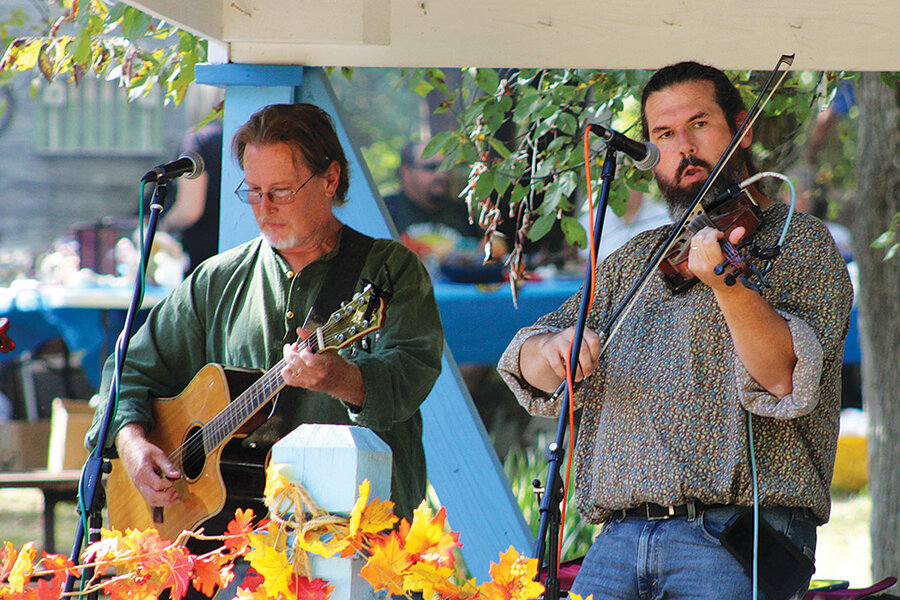Fiddler Dennis Stroughmatt saves a French dialect – and culture
Loading...
| Old Mines, Mo.
When Dennis Stroughmatt takes the stage with his fiddle in Old Mines, Missouri, he does more than entertain. He breathes new life into a language and culture that touch back to the 18th century.
Inspired to play his great-grandfather’s fiddle, Mr. Stroughmatt took up the instrument in his 20s. That journey brought him to Old Mines, where he met local Missouri French musicians Charlie Pashia and Roy Boyer, who became his teachers. They saw a future for their language and culture in Mr. Stroughmatt’s passion to learn.
Why We Wrote This
A story focused onPreserving dialects keeps communities – and their histories – alive. Dennis Stroughmatt honors his forebears who spoke, and sang, in French.
Today, Mr. Stroughmatt is one of the foremost experts on Missouri French, also called pawpaw French after a local fruit. He sees himself as a musical ambassador who aims to transcend language barriers and show the richness of the local heritage.
“I’m doing my part, and I’m proud of that,” he says when asked about his motivation for preserving a dialect spoken by fewer than 20 people. “I’m a big believer in the people and this pawpaw French culture; it’s a representation of who we are,” he adds. “So we need to protect that.”
A bright blue sky highlights the leaves of oak trees and white birches that line the clearing where La Fête d’Automne is underway. It’s a yearly fall festival that honors the French roots here in the Old Mines region, an hour south of St. Louis. The comforting smell of French donuts and hot cider hangs in the air. Hundreds of festivalgoers rummage through displays of wicker baskets, fabric, artwork, and books.
Soon all eyes fasten on Dennis Stroughmatt and his fiddle as he takes center stage with L’Esprit Créole, his folk band that’s been performing at the festival for more than two decades.
Mr. Stroughmatt, his hair pulled into a ponytail and the sleeves of his calico shirt rolled up to the elbow, smiles at the crowd as he lifts his bow and begins to play toe-tapping French Creole music as he sings in Missouri French. He’s doing what he loves, and in the process raising awareness of a fast-disappearing dialect and culture.
Why We Wrote This
A story focused onPreserving dialects keeps communities – and their histories – alive. Dennis Stroughmatt honors his forebears who spoke, and sang, in French.
“He plays, he sings in French, and everyone comes,” says Natalie Villmer with pride in her voice. She’s one of the directors of the local historical society that runs the festival.
“Not everybody understands [French], but they still like it,” she says. “C’est une jolie journée.” (It’s a beautiful day.)
Since first visiting Old Mines three decades ago as a student at Southeast Missouri State University, Mr. Stroughmatt has fiddled and lectured his way to becoming one of the foremost experts on Missouri French, also called pawpaw French after a local fruit. His efforts are gaining regional and national recognition. In 2012, he was a featured performer at the American Folklife Center at the Library of Congress and the Kennedy Center in Washington. He received an award from the Missouri governor in 2014 and was inducted into the National Oldtime Fiddlers Hall of Fame in 2015.
Mr. Stroughmatt sees himself as a musical ambassador who aims to transcend language barriers and show the richness of the local heritage.
“I’m doing my part, and I’m proud of that,” he says when asked about his motivation for preserving a dialect spoken by fewer than 20 people. “I’m a big believer in the people and this pawpaw French culture; it’s a representation of who we are,” he adds. “So we need to protect that.”
In Old Mines, or La Vieille Mine, the first French settlers came to extract lead as early as 1723. The rural community, which will be celebrating its 300th anniversary next year, spoke French decades before any English or Spanish word was heard. Today, Mr. Stroughmatt’s efforts come at a time of increasing national awareness around marginalized American cultures.
“I’m originally from Vincennes, Indiana. We didn’t really call it Missouri French or pawpaw French. Just French,” says Mr. Stroughmatt. “My interest grew from ... my fascination with the area’s heritage.”
Fabrice Jaumont, a researcher on bilingualism and co-editor of “French All Around Us,” a 2022 book that focuses on the presence of Molière’s language in the United States, says that emphasizing community roots reflects the spirit of our times.
“Keeping this connection with our linguistic heritage and passing it on, that’s growing in importance,” he notes. “It’s a combination of people recognizing how valuable bilingualism is today while also striving for dignity and wanting to honor their past through the language.”
There are signs of growing acceptance in the U.S. for languages other than English, adds Mr. Jaumont. Efforts to promote local languages are happening across the U.S., from the French-speaking communities of Louisiana to the Native tribes of Alaska.
Research shows that bilingualism can be beneficial to a child’s development and facilitates cultural understanding. In a globalized world, it’s a skill that helps connect with other mindsets and ideas, says Mr. Jaumont. Now, more than 40 states offer the Seal of Biliteracy, an award given to high school students who have gained mastery in two or more languages by graduation.
When Mr. Stroughmatt was in his 20s, he wanted to learn to play his great-grandfather’s fiddle. That’s when music helped him reconnect with his family’s past.
During a trip to Old Mines, he met local Missouri French musicians Charlie Pashia and Roy Boyer who became his teachers. They saw a future for their language and culture in Mr. Stroughmatt’s passion to learn. In 1997, Mr. Boyer pushed him to perform at La Fête d’Automne. He belted out “Le Rossignol Sauvage” and “Chevaliers de la Table Ronde” – and he’s been doing it ever since.
The more he performed, the more he wanted to share the region’s unique history. Soon he was visiting schools with his fiddle to lecture about Missouri French and share the songs that have resonated for three centuries. Mr. Stroughmatt has given nearly 1,000 school performances over the past 24 years.
Robert Green, a horn player and conductor, is part of the Alpine Artisans nonprofit – an organization that provides western Montana schools with live musical performances. “We’ve invited Mr. Stroughmatt three times, and each time it’s a hit,” says Mr. Green. “In his case, we have some wonderful applications for social studies, history, and music classes, because he knows a lot about the upper Mississippi French culture,” he adds. “He’s been a tremendous asset to us in many ways, singing of course, but also even sharing his insights on French Creole cuisine in a high school culinary class.”
Mr. Stroughmatt and his band mostly perform in Missouri French. The language is a combination of French and Native American vocabulary that emerged when French settlers came to North America in the 18th century, followed the Mississippi River downstream, and traded with the Missouria, Illinois, and Osage Native American tribes.
Pockets of French language remained for centuries in what used to be called Nouvelle-France, a territory that stretched along the Mississippi River all the way from the Gulf of Mexico to the Great Lakes and St. Lawrence River regions. Some 17th-century French words still linger today in Missouri French, like ouaouarons (bullfrogs) and chats-chouages (raccoons). But with the emergence of the middle class in the U.S. after World War II, speaking English was associated with success and prosperity, often leaving non-English speaking communities, like those of the Missouri French, behind, says Mr. Jaumont, the researcher.
At La Fête d’Automne, Mark Boyer is selling vintage novels and history books, including his own “300 Years of the French in Old Mines.” He’s a Roman Catholic priest, a historian, and a teacher at the University of Springfield, Missouri. Mr. Boyer grew up in the Old Mines region and recalls a time when he was discouraged from speaking French in school as a boy, even though at least four generations of his family had spoken it at home.
“My generation never learned it,” says Mr. Boyer. “In the mid-to-late 20th century, English was required in the schools,” he adds. “French was not well perceived, and bilingualism became simply English,” he says. But he’s encouraged by the possibility that Old Mines French could be known to a new generation of French speakers. “Dennis is the new representative for that,” he says.
The vibrancy of the annual La Fête d’Automne spurs that hope. A sign near the cider stand announces in Missouri French, “On est toujours icitte” – “We’re still here.” And as long as Mr. Stroughmatt is lifting his fiddle to his chin, folks here are reassured that they will dance, sing, and laugh in the autumn air for some time to come.
“Music itself ... can transcend verbal language,” says Mr. Stroughmatt. “And I hope it shows one thing: that French is not a foreign language. It’s part of this land.”










